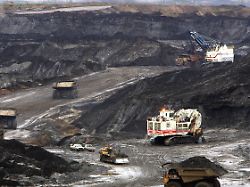Untouched nature and endless expanses – that is the prevailing image of Canada. However, there is also a dirty side. No other bank pumped more money into the fossil fuel industry in the past year than the country’s largest bank. This is no coincidence.
Last year, the world’s 60 largest banks invested USD 673 billion in fossil fuels such as oil, natural gas and coal. That’s from the report “Banking of Climate Chaos” emerged in which a group of environmental protection organizations evaluated financial databases. The total amount was lower than in 2021, but the study attributes this to the changed world situation. Because many large energy companies were able to generate record profits on oil and gas as a result of the Ukraine war, they would have needed fewer loans.
But one bank in particular falls out of line. The Royal Bank of Canada approved $42.1 billion in loans to the fossil fuel industry last year – bucking the industry trend, slightly more than a year earlier when it was $40.4 billion.
Richard Brooks, one of the initiators of the report, describes the Royal Bank of Canada as the largest financier of these deals as the “dirtiest bank in the world”. He missed the entire Canadian financial industry in the “Financial Times” the label “lender of last resort” because the Royal Bank of Canada is not an isolated case: Toronto-based Scotiabank also finances a particularly large number of dirty projects.
Forests, lakes and opencast mines
In fact, the second largest country in the world not only attracts with huge mountains, forest areas and lakes, but also with oil sand, which is a dirty billion dollar business, especially in the Canadian province of Alberta. Because when oil companies mine the quartz mixture, also known as tar sand, it damages the environment significantly more than conventional oil production. The opencast mines take up huge areas of land, their CO2 balance is miserable, and the water consumption is immense.
But many Canadian banks don’t mind. They invest where others have gotten too dirty, says Katrin Ganswindt from the environmental organization Urgewald, which worked on the “Banking of Climate Chaos” report. “The mining of oil sands is one of the dirtiest extraction methods there is. Various European banks are banning investments in this area, at least at the project level, and occasionally at the company level as well,” says Ganswindt. However, no decrease in lending can be observed at Canadian banks.
A fact that doesn’t really fit the Canadian image. And yet the government is holding back when it comes to climate protection, says financial economist Gregor Weiß from the University of Leipzig. “The fact that the oil sands business is still being expanded in some areas is actually out of date, but is probably due to the lack of political pressure.” Weiß calls the legal climate requirements for the energy sector “relatively soft”.
“National champions” stick together
The Royal Bank of Canada benefits from this. Its main oil sands clients are state-owned asset manager Canada Development Investment Corporation and energy giant Enbridge. Energy and finance campaigner Ganswindt von Urgewald speaks of national cohesion. “The ‘national champions’ among the companies are often financed by the country’s big banks. There may be critical inquiries, but they rarely turn away.”
A study by the financial company Profundo shows how dirty the business of the Royal Bank of Canada is. From 2016 to 2022, for every dollar invested in renewable energy projects, $99 was invested in fossil fuels. The head of the bank, David McKay, does not see the problem in himself. He claims there simply aren’t enough renewable projects for his bank to invest in. In addition, geopolitical tensions and the rising cost of living would make it difficult to exit oil and gas production in the short term.
Hard exit not feasible
For the financial economist Weiss, however, this is only half the truth. He, too, believes that an abrupt end to fossil investments is unfeasible: 140,000 people work in Alberta’s oil sands mining alone. That is why German banks, for example, are gradually phasing out and, for example, are ending new business that is particularly harmful to the environment. “But the Canadian banks don’t seem to have gotten that far yet because it’s such big business there,” says Weiss.
A big deal that the Royal Bank of Canada apparently wants to max out for as long as possible. Despite sometimes massive protests by climate activists and indigenous people, whose country is traversed by opencast mines and pipelines. At the annual general meeting in early April, just 17 percent of shareholders voted to set emissions targets by 2030. Good news for the board, because the Canadian competition authorities are already investigating allegedly misleading information on the climate footprint of the Royal Bank of Canada. The dirtiest bank in the world denies these allegations.
“Learned again” is a podcast for the curious: Why would a ceasefire be just a break for Vladimir Putin? Why does NATO fear the Suwalki Gap? Why does Russia have iPhones again? What small changes in behavior can save 15 percent of energy? Listen in and get a little smarter three times a week.
All episodes can be found in the ntv app, at RTL+ music, Apple Podcasts and Spotify. “Learned something again” is also included Amazon Music and Google Podcasts accessible. For all other podcast apps, you can use the RSS feed.
